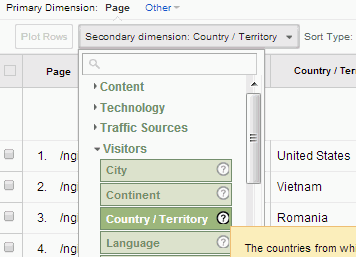Understanding Secondary Dimension in Google Analytics: A Full Overview
Understanding Secondary Dimension in Google Analytics: A Full Overview
Blog Article
Unlock Deeper Insights With Secondary Measurement in Google Analytics
With the substantial area of data available in Google Analytics, the utilization of second dimensions can significantly improve your logical capabilities. These additional layers of information use a nuanced point of view that can light up intricate details within your key metrics. By strategically including second measurements right into your evaluation, you can uncover important understandings that may or else continue to be undiscovered. The capacity to translate and divide user habits with greater precision opens up a world of possibilities for improving and optimizing techniques efficiency.
Understanding Key Vs. Second Dimensions
When evaluating data in Google Analytics, it is important to compare key and additional dimensions to acquire much deeper insights right into individual habits. Primary dimensions are the primary classifications whereby you can watch your information, such as tool, landing, or source/medium web page. These measurements provide the essential framework for organizing and comprehending your data. On the other hand, secondary dimensions allow you to further dissect your primary measurement data. By adding an additional measurement, you can layer on extra information to your main measurement, allowing an extra granular evaluation. If your primary measurement is the source/medium via which customers got here on your website, including a second dimension like geographic place can reveal where those users are situated geographically. When looking at the key measurement alone, this included layer of details can assist you identify fads, patterns, or anomalies that may not have actually been obvious. For that reason, leveraging both primary and second measurements in Google Analytics is critical for extensive information analysis and informed decision-making.
Utilizing Second Measurements Successfully
Successfully using secondary measurements in Google Analytics enhances the depth and granularity of information evaluation, providing important insights into user actions and patterns. By incorporating secondary measurements along with key dimensions, experts and marketing professionals can dive much deeper right into the specifics of individual interactions on their internet sites. Additional measurements permit customers to sector and filter main measurement data further, providing a much more detailed view of individual demographics, interactions, and actions. This can be especially helpful when trying to comprehend the impact of specific variables on customer engagement, such as the web browsers or gadgets they are using, the sources of their website traffic, or their geographic places.
Additionally, second measurements allow individuals to compare and contrast various data factors within a single report, helping with an extra detailed analysis of customer habits patterns. By leveraging secondary dimensions properly, services can uncover concealed insights, optimize their advertising and marketing techniques, and boost the overall user experience on their internet sites.
Discovering Typical Second Dimension Mixes
To even more analyze user behavior and trends in Google Analytics, it is beneficial to explore common combinations of second measurements. Some typical second measurement combinations that give important understandings include examining traffic resources with individual places to understand where web site site visitors are coming from geographically and how they found the site. Examining user behavior metrics with second go right here measurements such as demographics or passions can aid in targeting specific audience sections more effectively.
Applying Second Dimension in Custom News
Using additional measurements in custom reports enables a much more thorough analysis of data in Google Analytics, boosting the deepness of understandings acquired. When creating personalized reports in Google Analytics, incorporating secondary dimensions can provide an extra thorough sight of exactly how numerous measurements engage with each other. This feature makes it possible for customers to dive much deeper into their data and uncover beneficial connections that may not be right away evident.
By using second measurements in customized records, customers can acquire a far better understanding of their site or application web traffic. Combining the key measurement of "source/medium" with the secondary dimension of "touchdown web page" can expose which landing pages are executing ideal for website traffic coming from specific sources. This insight can help marketing experts maximize their projects and enhance total conversion prices.

Enhancing Data Visualization With Secondary Measurement
When checking out data in Google Analytics custom-made reports, integrating second dimensions not only supplies an extra comprehensive evaluation but additionally enhances the graph of insights with information visualization. By including a secondary dimension to your records, you can enrich the means data is offered, making it much easier to determine patterns, trends, and relationships within your web site's performance metrics.
Additional dimensions can aid you section your data additionally, permitting for a deeper understanding of individual actions and interactions on your site. When trying to isolate details variables that may influence your site's efficiency., this enhanced degree of granularity can be particularly useful.

Verdict
To conclude, leveraging additional measurements in Google Analytics enables for a more comprehensive evaluation of data, causing much deeper understandings and more informed decision-making. Secondary Dimension in Google Analytics. By adding extra layers of details to main information collections, analysts and marketers can discover concealed patterns, patterns, and correlations that provide a granular view of customer habits and interactions. This improved degree of understanding enables optimization of campaigns and tailored techniques for particular target market segments, eventually boosting performance and conversion prices
On the various other hand, second measurements allow you to additional explore your main dimension data. By including a second measurement, you can layer on additional info to your key dimension, allowing a more granular evaluation. If your key measurement is the source/medium through which customers arrived on your website, including a second measurement like geographic location can reveal where those individuals are situated geographically. By including additional dimensions along with key measurements, marketing experts and analysts can dive much deeper into the specifics of user communications on their sites. Second dimensions allow customers to section and filter key measurement information additionally, providing an extra visit our website thorough sight of individual actions, interactions, and demographics.
Report this page